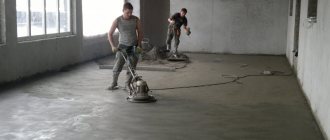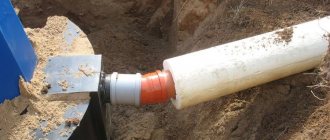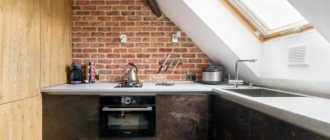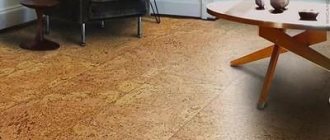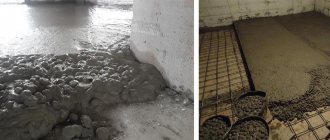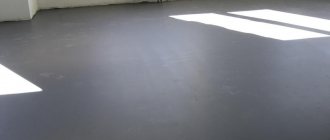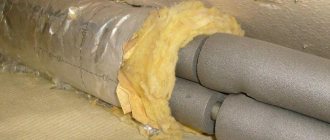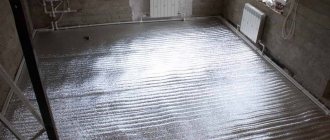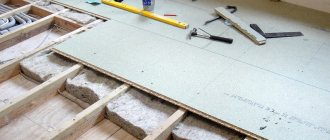Materials with low density, excellent thermal insulation characteristics and, at the same time, quite acceptable rigidity and the ability to withstand mechanical loads, open up wide possibilities for floor insulation, including even in apartments of multi-storey buildings. A typical representative of such materials is polystyrene foam. And such floor insulation with polystyrene foam under the screed is especially important on the first floors located above unheated basements or ventilated cold plinths.
Floor insulation with polystyrene foam under screed
As we will see later, you can carry out similar work yourself. The main thing is to purchase high-quality insulation material of the required thickness and strictly follow the technological recommendations for pouring the screed.
Penoplex screed - what kind of technology is it?
Penoplex boards have good density and strength; they are not afraid of high loads. Both sand and cement screed and self-leveling mixtures fit well on their flat surface.
Its homogeneous structure is similar to a whole arsenal of small cells measuring 0.2 mm in size. Unlike other insulation materials, it has virtually no vapor permeability and does not absorb moisture. Penoplex is produced by industry mainly in the form of rectangular slabs of different lengths, widths, and thicknesses.
For insulation, you can use not only slabs, but also polystyrene granules, which are sold in bags. Granules are added to the concrete solution to produce polystyrene concrete. But it is more convenient to use penoplex in slabs under floor screed for insulation.
An uninsulated floor leads to increased humidity in the house, which results in the appearance of fungal mold. The room loses up to 20% of heat through cold floors. People suffer from colds and leg joints suffer.
Before insulating floors with foam boards, you need to prepare the base. The concrete base is freed from dirt, potholes and irregularities are repaired. The earthen base is first covered with a sand cushion, and before screeding it is compacted and leveled.
Pros and cons of floor insulation under screed
Compared to other insulation materials, the manufacturing technology of tile penoplex is aimed at protecting the material from moisture absorption. Its closed cell structure gives the material frost resistance and compressive strength.
Penoplex on the floor under the screed has the following advantages:
- Expanded polystyrene boards are not subject to combustion, do not emit toxic fumes, are not afraid of high humidity, and do not wear out or rot for a long time. Their service life is determined to be 50 years.
- The material is endowed with a high thermal conductivity coefficient. Its value is 0.030 W/(m*C), which indicates its good thermal insulation properties. The vapor permeability coefficient is 0.007-0.008 mg/(m*hour*Pa). Its low vapor permeability is comparable to roofing felt.
- The high strength of the material allows you to place heavy pieces of furniture on it without fear of squeezing.
- The slabs are well cut to the required dimensions and are easy to install.
- The porous structure of penoplex gives the slabs light weight.
- Weather conditions do not interfere with working with the material.
Important! Penoplex panels do not lose their thermal insulation and other qualities throughout their entire service life.
The disadvantages of penoplex products include their high price, strong smoke during smoldering, and the fact that they are destroyed under the influence of chemical solvents and high temperatures.
Why foam?
The answer to this question is clear: the material has a number of undeniable advantages. For example:
- The structure of the foam is porous, which provides the material with low thermal conductivity. Accordingly, heat will not leave the room, and cold air will not get inside.
- Due to its structure, foam is not affected by moisture. Therefore, in some cases, you can save on laying a layer of waterproofing.
- Polystyrene foam belongs to the category of fireproof materials. It burns, of course, but without the constant presence of an open source of fire it quickly goes out.
- In addition, the material is lightweight, easy to use and is not subject to rotting or destruction over time.
The method of performing foam screed has its own characteristics and nuances. It is worth noting that the technology is quite simple, so absolutely anyone can cope with the work.
What brand and thickness of penoplex to choose
Penoplex is the same polystyrene foam that has undergone extrusion (remelting under pressure). During this process, its structure changes, the air mixture is compacted, the slabs gain density, and their service life increases.
In appearance they resemble polyurethane foam. “Penoplex” is not its only name. Some companies make it under the name polyspen or polyplex. Tile penoplex is widely used as thermal insulation in the construction of roads, bathhouses, garages on private plots, and apartment balconies.
Not every air mixture is suitable for floor screed. Types of penoplex suitable for floor insulation:
- “Comfort” with a density of 31 kg/m³ with slab thicknesses from 20 to 100 mm;
- “Foundation” with a density of 35 kg/m³ with a slab thickness of 50 to 80 mm;
- "Penoplex 45" with a density of 40-45 kg/m³ with a slab thickness of 40 to 100 mm.
They do not contain harmful ingredients, they do not absorb moisture, and the material does not lose its qualities at high and low temperatures. Its structure does not change even at air temperatures reaching +75°C and -100°C. Which one to choose depends on the location of the premises. An apartment above a cold basement should be insulated with denser slabs and greater thickness.
But regardless of the location of the apartment, preparatory work is carried out before insulating the floors. They include:
- cleaning surfaces from old paints, adhesives, litter and dust;
- sealing cracks and potholes;
- smoothing out irregularities;
- leveling surfaces.
After completing the cleaning and leveling process, the surface is covered with a layer of deep penetration primer. Walls to a height of 0.15-0.2 meters are also subject to primer. After the primer has dried, the surface is filled with a leveling mixture to level out minor differences in height.
Spreading, it fills all the cracks, cavities, evens out roughness and minor differences in horizontal heights. In rooms located above basements with high humidity, waterproofing is carried out.
A damper tape is glued along the entire internal perimeter of the rooms, which prevents cracking of the concrete base during expansion. Glue it so that it is at the level of the final finishing of the floor.
Having completed the preparatory process, you can begin laying the foam boards. Waterproofing is laid underneath them. A layer of sand is poured onto the concrete base. Penoplex screed can be wet or semi-dry. But no matter what method the owners choose, its minimum thickness cannot be less than 0.4 centimeters.
Solving the price-quality issue
, polystyrene foam and extruded polystyrene foam can be used together to maintain the quality of insulation and reduce the price.
The use of these two materials in combination is an excellent solution to the price-quality issue.
In this case, the concrete floor pie will be:
- Reinforced concrete slabs or monolith;
- foam layer, approximately 50-100 mm;
- layer of extruded polystyrene foam, approximately 30-50 mm;
- layer of cement-sand mortar;
- flooring.
The thermal performance indicators of these materials are similar, so the thickness will increase slightly due to the addition of polystyrene foam. The top durable layer can withstand high loads and save on screed reinforcement.
Insulating the floor with penoplex under the screed, step-by-step process
For insulation under the screed, it is wiser to use Penoplex-F. The letter "F" stands for foundation. It can withstand high compressive loads. They reach up to 27 kilograms per 1 sq. centimeter.
The slabs are laid gradually on a layer of sand. First, one area is sprinkled, and foam boards are laid on it with light pressure and hand movements from side to side to level the sand. Then they move on to the next section until they cover the entire floor.
When laying penoplex on a concrete base, it is first primed. The insulation is applied only after the primer has completely dried. It can be fixed to concrete with glue, putty or foam. In order for the gluing to be high-quality, the concrete surface must be carefully leveled. The joints of the plates are connected to each other with adhesive tape or tape.
When the heat-insulating floor material is completely laid, it is covered with plastic film to protect it from moisture, not forgetting to leave a small 15-centimeter overlap on the walls. This is necessary so that moisture does not get on the insulation from above.
To increase the strength of the base, reinforcement is made; a mesh with cells of 80*80 or 100*100 mm is applied to the film. A layer of sand and cement mortar up to 15 mm thick is evenly laid on top of it. The semi-dry screed is compacted, the masonry mesh is slightly raised and compacted again. To level the surface, beacons are installed in the corners of the room.
To prevent the screed from cracking when it hardens, it is sprayed with water until completely dry. Semi-dry screeds, due to the limited amount of water in them, dry faster, wet ones - 15-20 days. The finished foam screed can be covered with different flooring materials. Waterproofing in the form of a film is laid under laminate, parquet boards, and wooden coverings.
Additional Information! To prevent the screed from cracking as it expands during temperature fluctuations, damper tape is glued to the walls along the inner perimeter.
Staged layers of construction: concrete base, insulation, waterproofing, reinforcing mesh, cement-sand screed, finishing floor covering.
Introducing foam granules into the solution
Introducing foam granules into the solution
To create a concrete screed with foam plastic, slab material is not always used, because the surface can be given additional performance properties by introducing granules into the cement mortar. Foam granules will create an air layer, thereby ensuring good thermal insulation performance of the screed. This process is carried out in several stages.
Foam chips with cement
- A solution is prepared consisting of a small amount of water and the volume of cement required to obtain a mixture of creamy consistency. The mixing process becomes much faster and more efficient when using a drill with a suitable attachment.
- Continuing mixing, foam granules are added to the mixture. The ratio of ingredients varies: one part of concrete can contain three, four or even six parts of granular material.
The higher the percentage of granules in the solution, the better the thermal insulation properties of the screed. However, at the same time, it will be less durable, and when pressed it may even crumble, therefore, it will lose the lion’s share of its performance characteristics.
Foam chips are a material that solves the most pressing problems, being an ideal insulation material that is resistant to fires, severe fires and other types of damage, and at the same time economical and high quality
The choice of the desired proportion largely depends on how durable and rigid the finishing floor covering will be. For example, if you plan to use linoleum, then the volume of granules in the solution should be minimal, parquet - vice versa.
foam granules
Video - Polystyrene foam granules. Mixing with cement
Use with underfloor heating system
When installing a heated floor system with your own hands on the ground floor, it is also rational to use polystyrene foam or expanded polystyrene. The floor pipes are laid in the thickness of the cement layer, which in this case is made thicker than 80 mm. To increase strength, reinforcing mesh is used. A layer of polystyrene foam under the insulation ensures maximum system efficiency.
Options for underfloor heating
This video discusses all the technical details of installing a semi-dry screed on polystyrene foam:
The more expensive energy resources become, the more often the question of installing thermal insulation is raised, both in private houses and in apartment buildings. When carrying out repair or construction work, they try to insulate almost all premises, including non-residential ones. The availability of modern thermal insulation materials makes it possible to cope with this task without any problems.
What are the features of the material
Floor installation with penoplex
Penoplex for insulating concrete floors means a high-quality building material with high thermal insulation properties. It is made by foaming polystyrene, then extrusion is carried out: the foamed polystyrene is passed through special molding channels, then time is given for it to harden. Upon completion of all production activities, foam slabs are obtained, the structure of which contains many hollow cells filled with gases.
It is thanks to this structure that the material has a high ability to eliminate heat loss by insulating it. The standard dimensions of the slabs are 60×120 cm, 60×240 cm, the thickness of each slab varies from 2 cm to 10 cm.
Review of manufacturers
When choosing a model for insulating a garage floor with polystyrene foam, we pay attention to the manufacturer of this material. The main guarantee of a long service life is compliance with technology during manufacturing. Currently, there are a number of companies whose products meet quality standards. Among the foreign ones the following can be distinguished:
- Basf;
- Polimeri Europa;
- Nova Chemicals.
Products from Russian manufacturers are no less quality:
- TechnoNIKOL;
- Penoplex.
To create a heat-insulating layer, it is best to use materials of the same brand. Even a slight difference in manufacturing technology can affect their compatibility.
© 2021 prestigpol.ru
